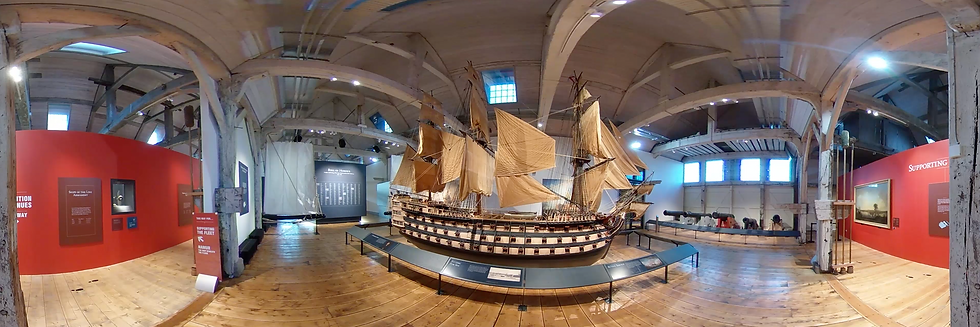Why VR?
- Ashleigh Hull
- Jun 4, 2018
- 4 min read
Updated: Dec 2, 2020
Our previous blog gives some excellent reasons why you would use video, or interactive video, for learning. But the elearning world is buzzing about VR, the next step up from those technologies. Is it just a gimmick? Or could VR actually enable greater learning?
So why VR?
VR replicates life
Hands-on experience is usually the best way to learn something, but that isn’t always available. If distance, danger, or cost make hands-on experience impossible, then VR is the next best thing.
This is where real world VR film works better than CGI VR or linear film - VR film replicates the environment, teaching learners what the situation would be like in the real world. And if it’s interactive (like the work Video Interact produce), so you can click and learn more when you want to, then it’s almost better than real life.
VR improves learning
There’s a lot that could be said here, but in essence, people learning through VR learn quicker, make fewer mistakes, and retain far more than with comparable video or traditional training [1]. With VR, learning is very natural and applicable to real world situations.
VR reduces costs
Just a couple of examples - Next Galaxy Corp is developing VR medical training that will reduce training cost per employee from $3000 to $40. And Boeing believe that VR can cut training time by 75%.
So when would I use VR?
VR is already being widely used for extreme circumstances where real-world training would be high-risk or expensive; military training, flight simulation, surgery, and so on. But the technology is daily becoming more accessible and flexible, and the possible applications are now much more widespread.
Discovery-based learning An objection to VR is that learners can miss important information because they’re looking in the wrong place. But that design challenge is actually one of VR’s strengths. Students can discover the learning material, rather than being spoon fed; actively engaging them with the learning.
Possible applications are virtual tours of galleries or museums (an application we have already experimented with). Or perhaps you could create a gamified VR experience that functions as a treasure hunt. Your own imagination is the limit here.

Training for the real world As I’ve said, VR mimics real world situations, and as a result learning is very natural and applicable. That means that VR training would add value in any real world scenario - particularly those where a complete view of a situation is useful.
For example, you could train managers in a restaurant chain with a VR simulated replica of the environment. Are they aware of the things going on around them? How do they prioritise tasks when several things require their attention?
The same would be true for a shop floor. You could use VR to train staff members on how to recognise and respond to suspicious behaviour; how shoplifters might operate; how to handle a challenging customer when there are other things demanding their attention; and so on.
In a warehouse or on a worksite, VR could be used for hazard spotting. It’s hard to simulate the noises and dangers of those environments in even an interactive video, and near impossible in a traditional elearning course. But the immersive simulation of VR would do exactly what you needed it to, creating an accurate replica of the real-world environment that the learners will be encountering. A learner might reach the end of a traditional elearning course and answer all the multiple choice questions correctly, but that doesn’t mean they’ll be able to react quickly and appropriately in the real-world environment. VR removes the transfer gap of those skills and behaviours.
In driving, you need a 360 awareness of what’s going on around you. VR is the perfect tool for training here, whether that’s teaching 17 year olds how to drive for the first time or training experienced drivers in maneuvering vehicles larger than what they’re used to.
That’s just a handful of examples - obviously, there are many, many more possible applications.

Accurate assessment As I’ve touched on already, VR allows you to assess how people actually behave in the environment they’ll be working in. People may know all the right answers to a quiz, but that doesn’t mean the desired behaviours and reactions are present. This makes VR incredibly valuable to learning providers and managers. Because it mimics reality, you can put your learners in a simulation of a situation they will face in the real world and see how they respond; a far more effective assessment than checking their answers on a test.
So what next?
VR is no longer the expensive realm of techy experts. With the tools now available, VR is as cheap and easy to produce as regular video. But it still takes skill to do it well - and that’s where experience comes in handy. Rather than trying to figure it out alone, why not let Video Interact do it for you?
-
Footnotes
[1] Some examples of VR improving learning:
VR has been proven to produce an 80% retention rate even a year after training, as compared to a mere 20% a week after traditional training. - Dr. Narendra Kini, CEO Miami Children’s Hospital
Google tested two groups in how to use on how to use an espresso machine, one with YouTube videos, and one with VR. The VR team not only learned quicker, but also made fewer mistakes, and took less time to operate the machinery. – Techradar
VR training for gallbladder dissection was tested vs conventional teaching for training surgical residents, and it was found that the VR group was 29% faster and were 6 times less likely to cause an error in the procedure – Annals of Surgery




Comments